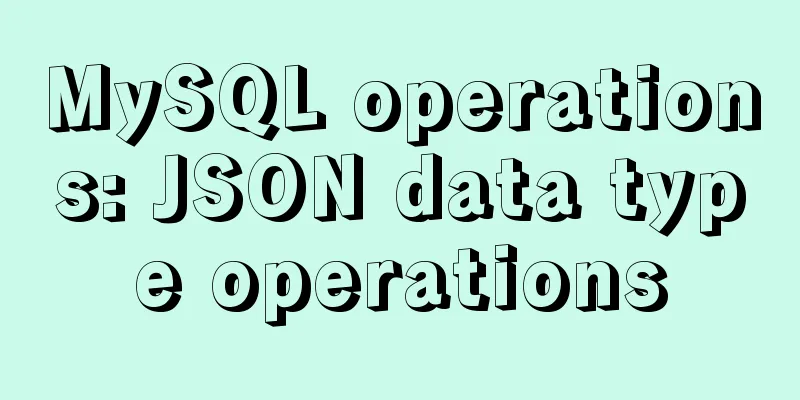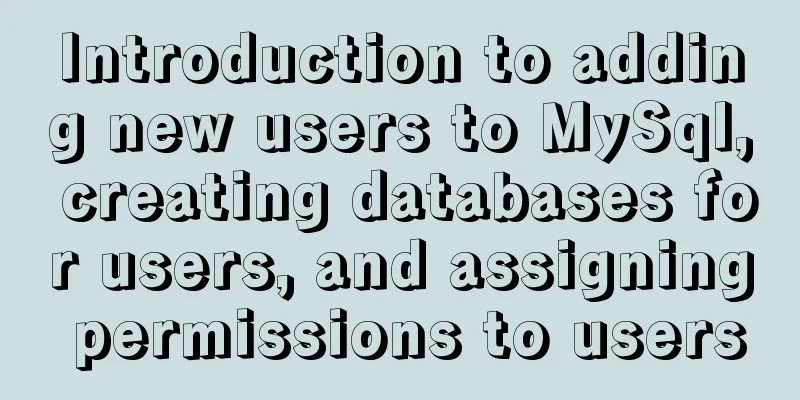MySQL operations: JSON data type operations

|
In the previous article, we introduced the detailed example of MySQL data storage procedure parameters. Today, let's take a look at the relevant content of MySQL operations on the JSON data type. Overview Since version 5.7.8, MySQL has supported the storage and query of JSON structured data, which shows that MySQL is also constantly learning and adding the advantages of NoSQL databases. But MySQL is a relational database after all, and it is still awkward when processing unstructured data such as JSON. Create a table with a JSON field First, create a table that contains a field in json format: CREATE TABLE table_name ( id INT NOT NULL AUTO_INCREMENT, json_col JSON, PRIMARY KEY(id) ); In the above statement, pay attention to the json_col field, which specifies the data type as JSON. Insert a simple JSON data
INSERT INTO
table_name (json_col)
VALUES
('{"City": "Galle", "Description": "Best damn city in the world"}');
In the above SQL statement, pay attention to the part after VALUES. Since double quotes are required to identify strings in json format data, the content after VALUES needs to be wrapped in single quotes. Insert a complex JSON data
INSERT INTO table(col)
VALUES('{"opening":"Sicilian","variations":["pelikan","dragon","najdorf"]}'); Here, we inserted a json array. The main thing is to pay attention to the problem of single quotes and double quotes. Modifying JSON Data In the previous example, we inserted several pieces of JSON data, but if we want to modify a certain content in the JSON data, how can we achieve it? For example, if we add an element to the variations array, we can do this: UPDATE myjson SET dict=JSON_ARRAY_APPEND(dict,'$.variations','scheveningen') WHERE id = 2; In this SQL statement, $ represents the JSON field, the dot is used to index the variations field, and then an element is added using the JSON_ARRAY_APPEND function. Now we execute the query: SELECT * FROM myjson The result is:
+----+-----------------------------------------------------------------------------------------+
| id | dict |
+---+-----------------------------------------------------------------------------------------+
| 2 | {"opening": "Sicilian", "variations": ["pelikan", "dragon", "najdorf", "scheveningen"]} |
+----+-----------------------------------------------------------------------------------------+
1 row in set (0.00 sec) For more information about how to obtain JSON data in MySQL, refer to the official link JSON Path Syntax Create Index MySQL's JSON format data cannot be indexed directly, but you can work around it by separating the data to be searched into a separate data column and then creating an index on this field. Here is the official example:
mysql> CREATE TABLE jemp (
-> c JSON,
-> g INT GENERATED ALWAYS AS (c->"$.id"),
-> INDEX i (g)
-> );
Query OK, 0 rows affected (0.28 sec)
mysql> INSERT INTO jemp (c) VALUES
> ('{"id": "1", "name": "Fred"}'), ('{"id": "2", "name": "Wilma"}'),
> ('{"id": "3", "name": "Barney"}'), ('{"id": "4", "name": "Betty"}');
Query OK, 4 rows affected (0.04 sec)
Records: 4 Duplicates: 0 Warnings: 0
mysql> SELECT c->>"$.name" AS name
> FROM jemp WHERE g > 2;
+--------+
| name |
+--------+
| Barney |
| Betty |
+--------+
2 rows in set (0.00 sec)
mysql> EXPLAIN SELECT c->>"$.name" AS name
> FROM jemp WHERE g > 2\G
*************************** 1. row ***************************
id: 1
select_type: SIMPLE
table: jemp
partitions: NULL
type: range
possible_keys: i
key: i
key_len: 5
ref: NULL
rows: 2
filtered: 100.00
Extra: Using where
1 row in set, 1 warning (0.00 sec)
mysql> SHOW WARNINGS\G
*************************** 1. row ***************************
Level: Note
Code: 1003
Message: /* select#1 */ select json_unquote(json_extract(`test`.`jemp`.`c`,'$.name'))
AS `name` from `test`.`jemp` where (`test`.`jemp`.`g` > 2)
1 row in set (0.00 sec) This example is very simple. It takes the id field in the JSON field and separates it into field g. Then, an index is created on field g, and the query condition is also on field g. Convert string to JSON format Convert a string in json format to MySQL's JSON type:
SELECT CAST('[1,2,3]' as JSON) ;
SELECT CAST('{"opening":"Sicilian","variations":["pelikan","dragon","najdorf"]}' as JSON);All MySQL JSON functions
Summarize The above is all the content of this article about the detailed explanation of JSON data type operations in MySQL. I hope it will be helpful to everyone. Interested friends can continue to refer to this site: Detailed example of MySQL data storage process parameter, brief description of the difference between Redis and MySQL, several important MySQL variables, etc. If there are any deficiencies, please leave a message and point them out. The editor will reply to you in time and make modifications, and strive to provide better articles and reading experience for the majority of programming enthusiasts and workers. Here are some books related to MySQL operation for your reference: MySQL Database Application from Beginner to Master (2nd Edition) PDF Scanned Version https://www.jb51.net/books/361239.html MySQL5 Definitive Guide (3rd Edition) Chinese version PDF scanned version https://www.jb51.net/books/367031.html I hope you like it. For more exciting content, please visit: https://www.jb51.net/ You may also be interested in:
|
<<: Setting up shared folders in Ubuntu virtual machine of VMWare14.0.0
>>: React-Native environment setup and basic introduction
Recommend
Several ways to run Python programs in the Linux background
1. The first method is to use the unhup command d...
HTML basic summary recommendation (text format)
HTML text formatting tags 標簽 描述 <b> 定義粗體文本 ...
Advanced crawler - Use of Scrapy_splash component for JS automatic rendering
Table of contents 1. What is scrapy_splash? 2. Th...
Vue network request scheme native network request and js network request library
1. Native network request 1. XMLHttpRequest (w3c ...
JS object copying (deep copy and shallow copy)
Table of contents 1. Shallow copy 1. Object.assig...
Detailed explanation of transaction isolation levels in MySql study notes
background When we talk about transactions, every...
Vue's various implementation methods for modifying parent component props through child components
Table of contents Preface Common methods 1. Modif...
Detailed explanation of for loop and double for loop in JavaScript
for loop The for loop loops through the elements ...
Detailed steps to use Redis in Docker
1. Introduction This article will show you how to...
vue-admin-template dynamic routing implementation example
Provide login and obtain user information data in...
Simple comparison of meta tags in html
The meta tag is used to define file information an...
Detailed explanation of JS browser event model
Table of contents What is an event A Simple Examp...
How to use indexes to optimize MySQL ORDER BY statements
Create table & create index create table tbl1...
How to use javascript to do simple algorithms
Table of contents 1 Question 2 Methods 3 Experime...
How to dynamically add ports to Docker without rebuilding the image
Sometimes you may need to modify or add exposed p...









